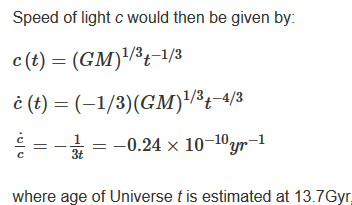An Accelerating Universe, or Light Slowing Down?
February 2, 1999
Astronomers have recently announced that the universe appears to be expanding at an accelerating rate. This is inferred because distant supernovae are unexpectedly dim. This is interpreted as implying that the expansion of the universe is faster now than it was before. This expansion is in turn explained by some mysterious repulsive force that is pushing the universe apart.
Another possible explanation is that the speed of light is slowing down. This explanation would avoid the need for such a repulsive force. But in order to understand this explanation, we need to understand more about the red shift.
Cosmologists believe that the red shift of light is caused by the expansion of space as light travels from distant objects. This expansion of space causes the light waves to become farther apart, and thus longer, and red shifted. The more time light has been traveling, the more time there has been for space to expand, and the greater the red shift. Thus more distant objects have a larger red shift.
Originally, it was believed that the red shift was proportional to distance (Hubble's law). However, the accelerating expansion of the universe was inferred because distant supernovae are fainter than expected based on their red shift. This means that they are farther away than one would expect based on the linear increase of red shift with distance. So if we let r(d) be the red shift of an object that is distance d away from us, then r(d) increases rapidly for objects near us, but then more slowly for objects farther away. Thus these objects are fainter than they would be if the red shift function r(d) were a constant multiple of d.
This is interpreted as evidence that the universe was expanding more slowly in the past, so that the red shift of distant objects is less than one would expect. When the light from distant objects began its journey, the universe, and therefore space, was expanding more slowly. Thus there was a smaller contribution to the red shift than for light that traveled more recently. Nearer objects are less subject to this slowdown, because the universe was expanding faster when light left them. Thus their red shift is comparatively larger, in proportion to their distance from us.
Suppose that a distant object is at distance d = d1 + d2 from us. Its red shift is then r1(d1) + r2(d2), where r1(d1) is the contribution to its redshift during the initial transit of light through a distance of d1, and r2(d2) is the contribution to the redshift from the final transit through a distance of d2. We can assume that r1(d1) = c1 * d1 and r2(d2) = c2 * d2, where c1 < c2 because the universe was expanding more slowly in the past. For an object at distance d2 from us, the red shift will be c2 * d2. Hubble's law would give the red shift for the distant object as c2 * (d1 + d2), which is c2 * d1 + c2 * d2. Since c1 < c2, this is larger than the observed red shift for the distant object. Thus we have that distant objects have a smaller red shift than one would expect, based on Hubble's law. In this way, this observation can be explained by an accelerating expansion of the universe.
This effect can also be explained by a slowdown in the speed of light. If light were traveling faster originally, then a slowdown would make distant objects appear fainter. The reason these supernovae would appear fainter is that light was traveling faster when it left them. This would make these objects appear farther away than they really are. This would also mean that the light spent less time in transit, so that there would be less time for space to expand, and thus the red shift would be reduced. Since light was traveling faster through the initial distance of d1 than through the final distance of d2, the contribution to the redshift would be proportionally larger from d2 than from d1. Both effects would mean that distant objects would tend to be much dimmer, and apparently farther away, than one would expect based on their redshift according to Hubble's law.
This explanation does not assume that the red shift itself is caused by a slowdown in the speed of light, although that is another interesting possibility. We are assuming that when light slows down, its apparent frequency is unchanged. However, other assumptions can also be considered.
Величина изменения скорости света порядка 1,5 - 2 ...
+ развернуть текст сохранённая копия
wpiter wrote:
Величина изменения скорости света порядка 1,5 - 2 сантиметра в секунду за год.
А я больше доверяю Луйзе:
Тэги:
материя,
темная,
физика
Теория сжатия Вселенной версия #8 15 - 16 годов
2017-02-01 17:44:23
wpiter wrote:
я достаточно точно рассчитываю параметры Вселенной ...
+ развернуть текст сохранённая копия
wpiter wrote:
я достаточно точно рассчитываю параметры Вселенной...
Отрицая всю современную математику? Упорными медитациями и наблюдениями потолка?

Тэги:
материя,
темная,
физика
Теория сжатия Вселенной версия #8 15 - 16 годов
2017-02-01 17:40:13
я достаточно точно рассчитываю параметры Вселенной...
Величина изменения скорости света ...
+ развернуть текст сохранённая копия
я достаточно точно рассчитываю параметры Вселенной...
Величина изменения скорости света порядка 1,5 - 2 сантиметра в секунду за год.
Изменение гравитационной "константы".
dG/G = (2 - 4)dC/C.
Тэги:
материя,
темная,
физика



